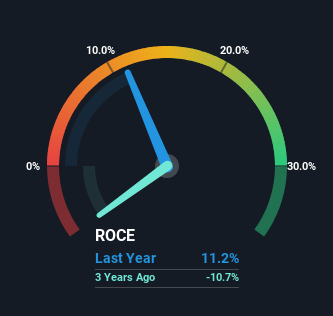We Like These Underlying Return On Capital Trends At Royal Caribbean Cruises (NYSE:RCL)
If you're looking for a multi-bagger, there's a few things to keep an eye out for. Amongst other things, we'll want to see two things; firstly, a growing return on capital employed (ROCE) and secondly, an expansion in the company's amount of capital employed. Ultimately, this demonstrates that it's a business that is reinvesting profits at increasing rates of return. Speaking of which, we noticed some great changes in Royal Caribbean Cruises' (NYSE:RCL) returns on capital, so let's have a look.
Return On Capital Employed (ROCE): What Is It?
For those that aren't sure what ROCE is, it measures the amount of pre-tax profits a company can generate from the capital employed in its business. Analysts use this formula to calculate it for Royal Caribbean Cruises:
Return on Capital Employed = Earnings Before Interest and Tax (EBIT) ÷ (Total Assets - Current Liabilities)
0.11 = US$2.9b ÷ (US$35b - US$9.4b) (Based on the trailing twelve months to December 2023).
Thus, Royal Caribbean Cruises has an ROCE of 11%. That's a relatively normal return on capital, and it's around the 9.5% generated by the Hospitality industry.
Check out our latest analysis for Royal Caribbean Cruises
In the above chart we have measured Royal Caribbean Cruises' prior ROCE against its prior performance, but the future is arguably more important. If you'd like to see what analysts are forecasting going forward, you should check out our free analyst report for Royal Caribbean Cruises .
The Trend Of ROCE
Investors would be pleased with what's happening at Royal Caribbean Cruises. Over the last five years, returns on capital employed have risen substantially to 11%. The amount of capital employed has increased too, by 25%. This can indicate that there's plenty of opportunities to invest capital internally and at ever higher rates, a combination that's common among multi-baggers.
The Key Takeaway
In summary, it's great to see that Royal Caribbean Cruises can compound returns by consistently reinvesting capital at increasing rates of return, because these are some of the key ingredients of those highly sought after multi-baggers. Since the stock has only returned 12% to shareholders over the last five years, the promising fundamentals may not be recognized yet by investors. Given that, we'd look further into this stock in case it has more traits that could make it multiply in the long term.
If you'd like to know more about Royal Caribbean Cruises, we've spotted 2 warning signs, and 1 of them is a bit unpleasant.
For those who like to invest in solid companies, check out this free list of companies with solid balance sheets and high returns on equity.
Have feedback on this article? Concerned about the content? Get in touch with us directly. Alternatively, email editorial-team (at) simplywallst.com.
This article by Simply Wall St is general in nature. We provide commentary based on historical data and analyst forecasts only using an unbiased methodology and our articles are not intended to be financial advice. It does not constitute a recommendation to buy or sell any stock, and does not take account of your objectives, or your financial situation. We aim to bring you long-term focused analysis driven by fundamental data. Note that our analysis may not factor in the latest price-sensitive company announcements or qualitative material. Simply Wall St has no position in any stocks mentioned.

